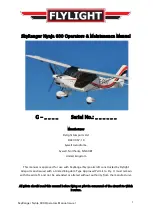
18
ANDA manual EN-v1.01 January 2023
Recovery Techniques
The second method is to pull gently on the A-risers. This helps the airflow to re-attach to the leading edge, but be
careful not to pull down too hard as this will induce a front collapse.
If the deep stall is particularly stubborn and the previous methods do not work then a full stall will solve the problem.
To do this apply both brakes fairly quickly, as if to do a strong stall, then immediately release both brakes and damp
out the forward surge in the normal way. The canopy will swing behind you then automatically reinflate and surge
forward in front of you before returning to normal flight. It is the surge forward that exits the canopy from deep stall.
Spins
Spins are dangerous and should not be practised in the course of normal flying. Spins occur when the pilot tries
to turn too fast. In a spin the pilot, lines and canopy basically stay vertical and rotate around a vertical axis. Your
glider will resist spinning, but if a spin is inadvertently induced you should release the brake pressure but always be
ready to damp out any dive as the glider exits the spin. Failure to damp the dive on exiting the spin may result in an
asymmetric deflation.
Symmetric Front Collapse
It is possible that turbulence can cause the front of the wing to symmetrically collapse, though active piloting can
largely prevent this from occurring. During the early stages of a front collapse the pilot should apply the brakes
symmetrically on both sides for a maximum of one second. This will push the air from the back of the canopy towards
the front, stopping the collapse from becoming deep. Make sure the brakes are fully released during the later stages
of the collapse, or this may induce a full stall. The glider will normally recover on its own as long as the pilot keeps the
brakes up. If the glider does not recover on its own it may be necessary to make a second pump on the brakes.
A pilot can reproduce the effect during an SIV course by taking hold of both the A-risers and pulling down sharply on
them, then immediately releasing. Make sure that you pull all four A-risers at the same time, two risers in each hand
(make sure to include the baby-A risers). The glider will automatically recover on its own from this situation in around















































